Phreatic Line Calculation of Reservoir Landslide under Complex Hydraulic Conditions—A Case Study
Abstract
1. Introduction
2. Method
2.1. Basic Assumptions
2.2. Simplification of Differential Equations
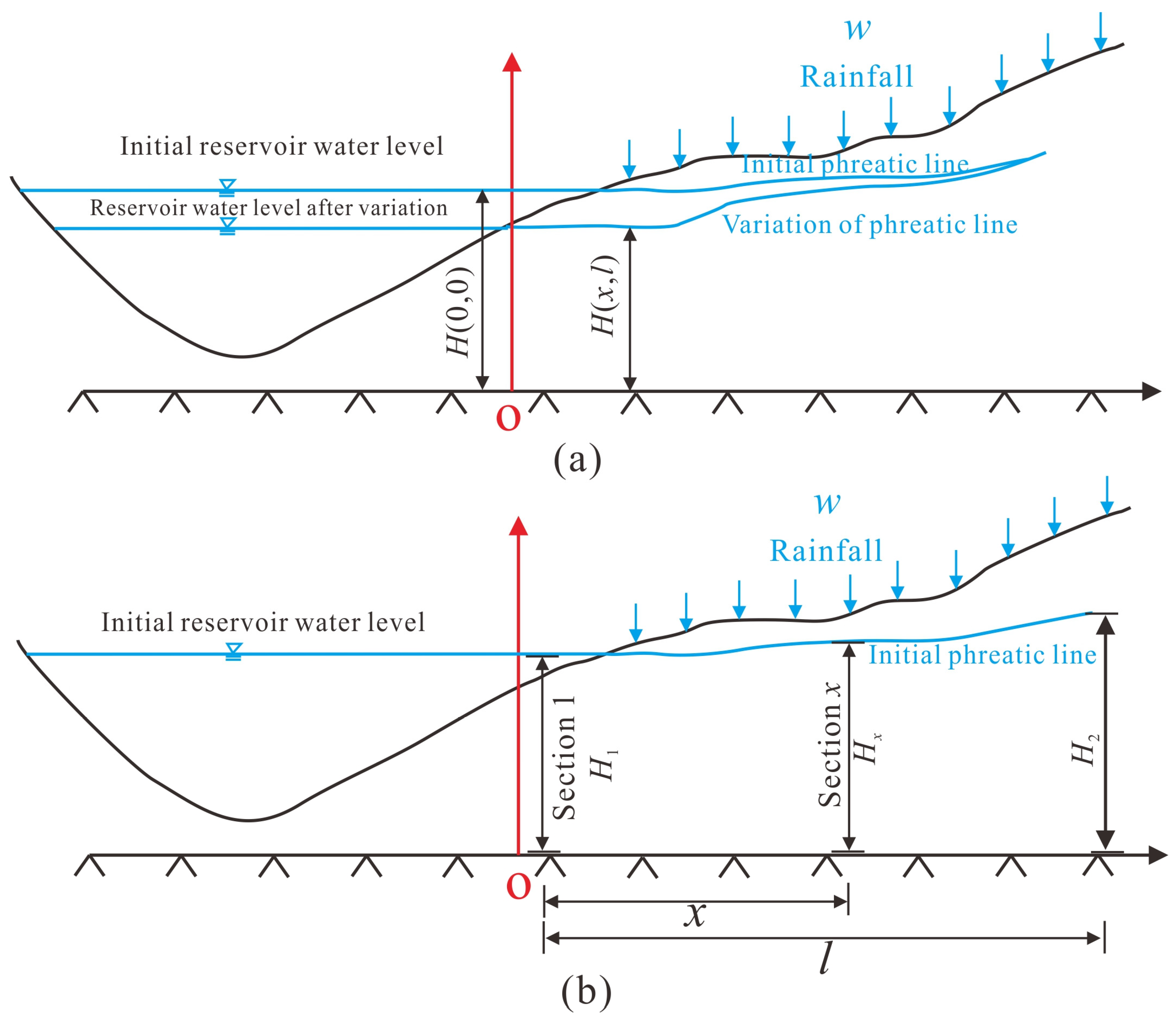
2.3. Calculation of Differential Equations
2.3.1. The Solution of the Initial Phreatic Line
2.3.2. The Solution of Differential Equation
3. Case Study: Majiagou Landslide
3.1. Regional Geological Setting
3.2. Engineering Geological Setting of Majiagou Landslide
3.2.1. Location of Majiagou Landslide
3.2.2. Geomorphological Setting of Majiagou Landslide
3.2.3. Stratigraphic Lithology
3.3. Monitoring System
3.3.1. Rainfall Monitoring
3.3.2. Reservoir Water Level and Groundwater Level Monitoring
3.4. Results and Analysis
3.4.1. Rainfall
3.4.2. Fluctuation of Reservoir Water Level and Groundwater Level
3.5. Model Verification
4. Discussion
4.1. The Innovation of This Study
4.2. Error Analysis and Limitations of the Proposed Method
5. Conclusions
Author Contributions
Funding
Data Availability Statement
Acknowledgments
Conflicts of Interest
References
- Tang, H.M.; Wasowski, J.; Juang, C.H. Geohazards in the three Gorges Reservoir Area, China- Lessons learned from decades of research. Eng. Geol. 2019, 261, 105267. [Google Scholar] [CrossRef]
- Lin, P.; Liu, X.; Zhang, J. The simulation of a landslide-induced surge wave and its overtopping of a dam using a coupled ISPH model. Eng. Appl. Comp. Fluid. 2015, 9, 432–444. [Google Scholar] [CrossRef][Green Version]
- Tan, H.; Chen, S. A hybrid DEM-SPH model for deformable landslide and its generated surge waves. Adv. Water Resour. 2017, 108, 256–276. [Google Scholar] [CrossRef]
- Zhang, L.; Shi, B.; Zhang, D.; Sun, Y.J.; Inyang, H.I. Kinematics, triggers and mechanism of Majiagou landslide based on FBG real-time monitoring. Environ. Earth Sci. 2020, 79, 200. [Google Scholar] [CrossRef]
- Zhang, L.; Zhu, H.; Han, H.; Shi, B. Fiber optic monitoring of an anti-slide pile in a retrogressive landslide. J. Rock Mech. Geotech. Eng. 2023, 16, 333–343. [Google Scholar] [CrossRef]
- Zhang, L.; Cui, Y.; Zhu, H.; Wu, H.; Han, H.; Yan, Y.; Shi, B. Shear deformation calculation of landslide using distributed strain sensing technology considering the coupling effect. Landslides 2023, 20, 1583–1597. [Google Scholar] [CrossRef]
- Genevois, R.; Tecca, P.R. The Vajont landslide: State-of-the-art. Ital. J. Eng. Geol. Environ. 2013, 15–39. [Google Scholar] [CrossRef]
- Wolter, A.; Stead, D.; Clague, J.J. A morphologic characterisation of the 1963 Vajont Slide, Italy, using long-range terrestrial photogrammetry. Geomorphology 2014, 206, 147–164. [Google Scholar] [CrossRef]
- Boon, C.W.; Houlsby, G.T.; Utili, S. New insights into the 1963 vajont slide using 2D and 3D distinct-element method analyses. Géotechnique. 2014, 64, 800–816. [Google Scholar] [CrossRef]
- Ibañez, J.P.; Hatzor, Y.H. Rapid sliding and friction degradation: Lessons from the catastrophic Vajont landslide. Eng. Geol. 2018, 244, 96–106. [Google Scholar] [CrossRef]
- Jian, W.; Xu, Q.; Yang, H.; Wang, F. Mechanism and failure process of Qianjiangping landslide in the Three Gorges Reservoir, China. Environ. Earth Sci. 2014, 72, 2999–3013. [Google Scholar] [CrossRef]
- Yin, Y.P.; Huang, B.; Chen, X.; Liu, G.; Wang, S. Numerical analysis on wave generated by the Qianjiangping landslide in Three Gorges Reservoir, China. Landslides 2015, 12, 355–364. [Google Scholar] [CrossRef]
- Ma, J.; Tang, H.; Hu, X.; Bobet, A.; Zhang, M.; Zhu, T.; Song, Y.; Ez Eldin, M.A.M. Identification of causal factors for the Majiagou landslide using modern data mining methods. Landslides 2017, 14, 311–322. [Google Scholar] [CrossRef]
- Zhang, L.; Shi, B.; Zhu, H.; Yu, X.B.; Han, H.; Fan, X. PSO-SVM-based deep displacement prediction of Majiagou landslide considering the deformation hysteresis effect. Landslides 2021, 18, 179–193. [Google Scholar] [CrossRef]
- Zhang, L.; Shi, B.; Zhu, H.; Yu, X.; Wei, G. A machine learning method for inclinometer lateral deflection calculation based on distributed strain sensing technology. Bull. Eng. Geol. Environ. 2020, 79, 3383–3401. [Google Scholar] [CrossRef]
- Ye, X.; Zhu, H.H.; Wang, J.; Zhang, Q.; Shi, B.; Schenato, L.; Pasuto, A. Subsurface multi-physical monitoring of a reservoir landslide with the fiber-optic nerve system. Geophys. Res. Lett. 2022, 49, e2022GL098211. [Google Scholar] [CrossRef]
- Han, H.; Shi, B.; Zhang, L. Prediction of landslide sharp increase displacement by SVM with considering hysteresis of groundwater change. Eng. Geol. 2021, 280, 105876. [Google Scholar] [CrossRef]
- Kafle, L.; Xu, W.J.; Zeng, S.Y.; Nagel, T. A numerical investigation of slope stability influenced by the combined effects of reservoir water level fluctuations and precipitation: A case study of the Bianjiazhai landslide in China. Eng. Geol. 2022, 297, 106508. [Google Scholar] [CrossRef]
- Yang, B.; Yin, K.; Xiao, T.; Chen, L.; Du, J. Annual variation of landslide stability under the effect of water level fluctuation and rainfall in the Three Gorges Reservoir, China. Environ. Earth Sci. 2017, 76, 564. [Google Scholar] [CrossRef]
- Huang, F.; Luo, X.; Liu, W. Stability analysis of hydrodynamic pressure landslides with different permeability coefficients affected by reservoir water level fluctuations and rainstorms. Water 2017, 9, 450. [Google Scholar] [CrossRef]
- Hou, T.S.; Xu, G.L.; Zhang, D.Q.; Liu, H.Y. Stability analysis of Gongjiacun landslide in the three Gorges Reservoir area under the action of reservoir water level fluctuation and rainfall. Nat. Hazards 2022, 114, 1647–1683. [Google Scholar] [CrossRef]
- Yan, Y.; Cui, Y.F.; Huang, X.H.; Zhou, J.J.; Zhang, W.G.; Yin, S.Y.; Guo, J.; Hu, S. Combining seismic signal dynamic inversion and numerical modeling improves landslide process reconstruction. Earth Surf. Dyn. 2022, 10, 1233–1252. [Google Scholar] [CrossRef]
- Yan, Y.; Tang, H.; Hu, K.H.; Turowski, J.M.; Wei, F.Q. Deriving debris-flow dynamics from real-time impact-force measurements. J. Geophys. Res.-Earth Surf. 2023, 128, e2022JF006715. [Google Scholar] [CrossRef]
- Nie, J.Y.; Cui, Y.; Wu, Z.; Zhang, L.; Fang, J. DEM study on role of fines in mobility of dry granular flows considering particle size-shape correlation. Comput. Geotech. 2024, 166, 105980. [Google Scholar] [CrossRef]
- Nie, J.Y.; Cui, Y.; Wang, G.; Wang, R.; Zhang, N.; Zhang, L.; Wu, Z. A comprehensive numerical investigation of multi-scale particle shape effects on small strain stiffness of sands. Géotechnique 2024, 74, 1–12. [Google Scholar]
- Ye, X.; Zhu, H.; Cheng, G.; Pei, H.; Shi, B.; Schenato, L.; Pasuto, A. Thermo-hydro-poro-mechanical responses of a reservoir-induced landslide tracked by high-resolution fiber optic sensing nerves. J. Rock Mech. Geotech. Eng. 2024, in press. [CrossRef]
- Yan, Z.L.; Wang, J.J.; Chai, H.J. Influence of water level fluctuation on phreatic line in silty soil model slope. Eng. Geol. 2010, 113, 90–98. [Google Scholar] [CrossRef]
- Huang, G.H.; Wang, H.; Adoko, A.C. Dam phreatic line simulation on FLAC3D: A case study. Appl. Mech. Mater. 2023, 353, 407–410. [Google Scholar]
- Yang, H.; Tang, M.; Xu, Q.; Xiao, X.; Li, H. Modification of phreatic line calculation model for landslide accumulation in the Three Gorges Reservoir area. Bull. Eng. Geol. Environ. 2022, 81, 175. [Google Scholar] [CrossRef]
- Cheng, L.; Zhang, A.; Cao, B.; Yang, J.; Hu, L.; Li, Y. An experimental study on monitoring the phreatic line of an embankment dam based on temperature detection by OFDR. Opt. Fiber Technol. 2021, 63, 102510. [Google Scholar] [CrossRef]
- Zhang, C.; Chai, J.; Cao, J.; Xu, Z.; Qin, Y.; Lv, Z. Numerical simulation of seepage and stability of tailings dams: A case study in Lixi, China. Water 2020, 12, 742. [Google Scholar] [CrossRef]
- Sun, Y.; Yang, K.; Hu, R.; Wang, G.; Lv, J. Model test and numerical simulation of slope instability process induced by rainfall. Water 2022, 14, 3997. [Google Scholar] [CrossRef]
- Xiong, X.; Matsumoto, T.; Shi, Z.; Zhang, F. Flume tests and corresponding numerical simulation of hydraulic/mechanical behavior of Tangjiashan landslide dam subjected to seepage loading. Soils Found. 2022, 62, 101200. [Google Scholar] [CrossRef]
- Jaswal, M.; Sinha, R.K.; Sen, P. Delineation of phreatic surface in soil type slope—A comparative study using physical and numerical modeling. J. Min. Sci. 2020, 56, 494–504. [Google Scholar] [CrossRef]
- Zheng, Y.R.; Shi, W.M.; Kong, W.X. Calculation of seepage force and groundwater wetting line when reservoir water level drops. Chin. J. Rock Mech. Eng. 2004, 18, 3203–3210. [Google Scholar]
- Wu, Q.; Lin, Z.H. Analytical Solution of the Wet Line in the Layer Bank Slope when the Reservoir Water Level drops. Geol. Sci. Technol. 2007, 2, 91–94. [Google Scholar]
- Wu, Q.; Tang, H.M.; Wang, L.Q.; Lin, Z.H. Study on the wetting line of reservoir bank slope under the action of water level rise and fall combined with rainfall. Rock Soil Mech. 2009, 30, 3025–3031. [Google Scholar]
- Sun, G.; Lin, S.; Jiang, W.; Yang, Y. A simplified solution for calculating the phreatic line and slope stability during a sudden drawdown of the reservoir water level. Geofluids 2018, 2018, 1859285. [Google Scholar] [CrossRef]
- Sun, G.; Yang, Y.; Cheng, S.; Zheng, H. Phreatic line calculation and stability analysis of slopes under the combined effect of reservoir water level fluctuations and rainfall. Can. Geotech. J. 2017, 54, 631–645. [Google Scholar] [CrossRef]
- Hua, S.; Li, Y.A.; Zhao, B.B.; Wang, Y.W.; Hu, Y.; Xiao, J.F. Analytical Solutions for Phreatic Line in Bank Slope Under the Combined Effect of Rainfall and Reservoir Water Level Fluctuation. Electron. J. Geotech. 2015, 20, 1439–1448. [Google Scholar]
- Sun, Y.J.; Zhang, D.; Shi, B.; Tong, H.J.; Wei, G.Q.; Wang, X. Distributed acquisition, characterization and process analysis of multi-field information in slopes. Eng. Geol. 2014, 182, 49–62. [Google Scholar] [CrossRef]
- Zhang, Y.M. Multifield Characteristics and Evolution Mechanism of Majiagou Landslide-Stabilizing Piles System under Reservoir Operations. Doctoral Dissertation, China University of Geoscience (Wuhan), Wuhan, China, 2018. (In Chinese with English abstract). [Google Scholar]
- Chan, A.H.C.; Pastor, M.; Schrefler, B.A.; Siomi, T.; Zienkiewicz, O.C. Computational Geomechanics, Theory and Applications, 2nd ed.; Wiley: New York, NY, USA, 2022. [Google Scholar]
- Gardner, W.R. Some steady-state solutions of the unsaturated moisture flow equation with application to evaporation from a water table. Soil Sci. 1958, 85, 228–232. [Google Scholar] [CrossRef]
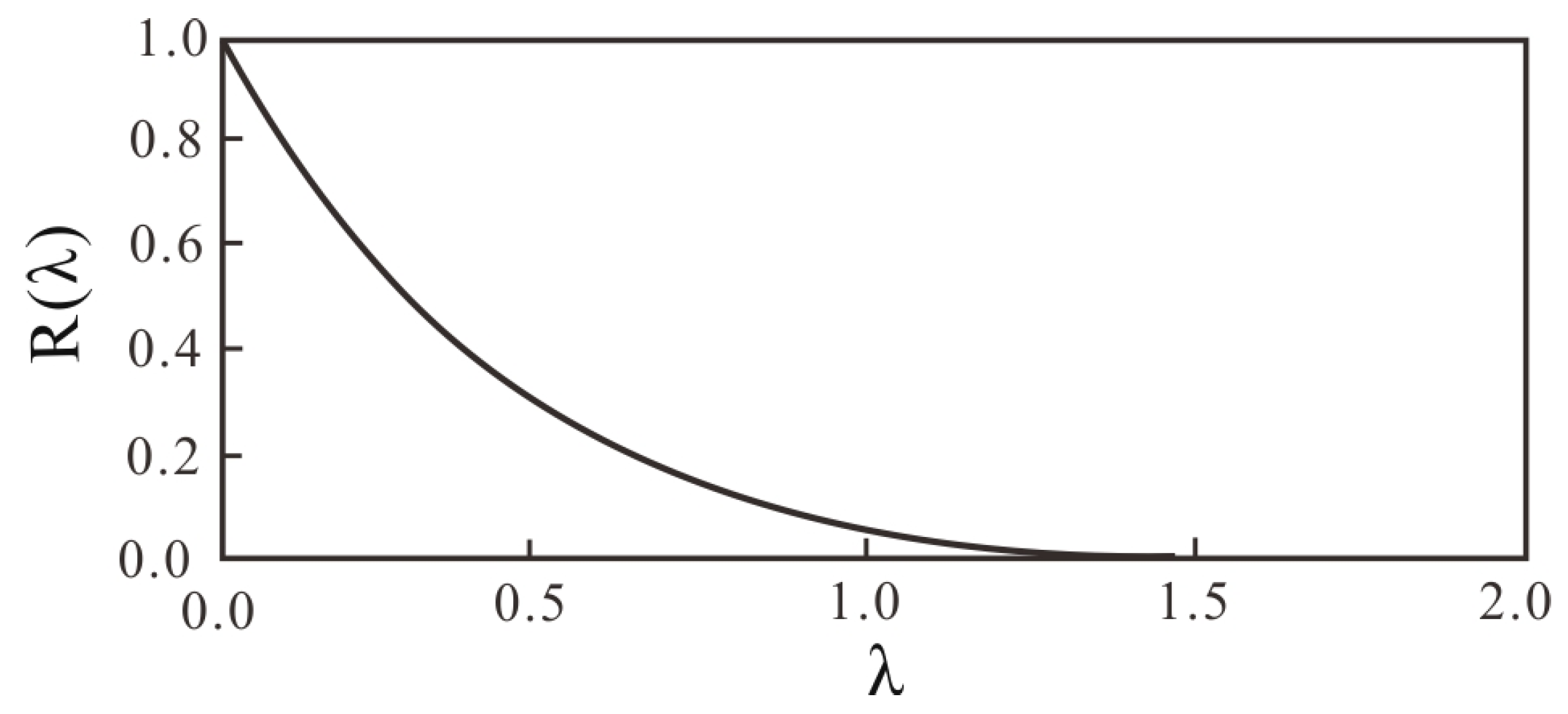
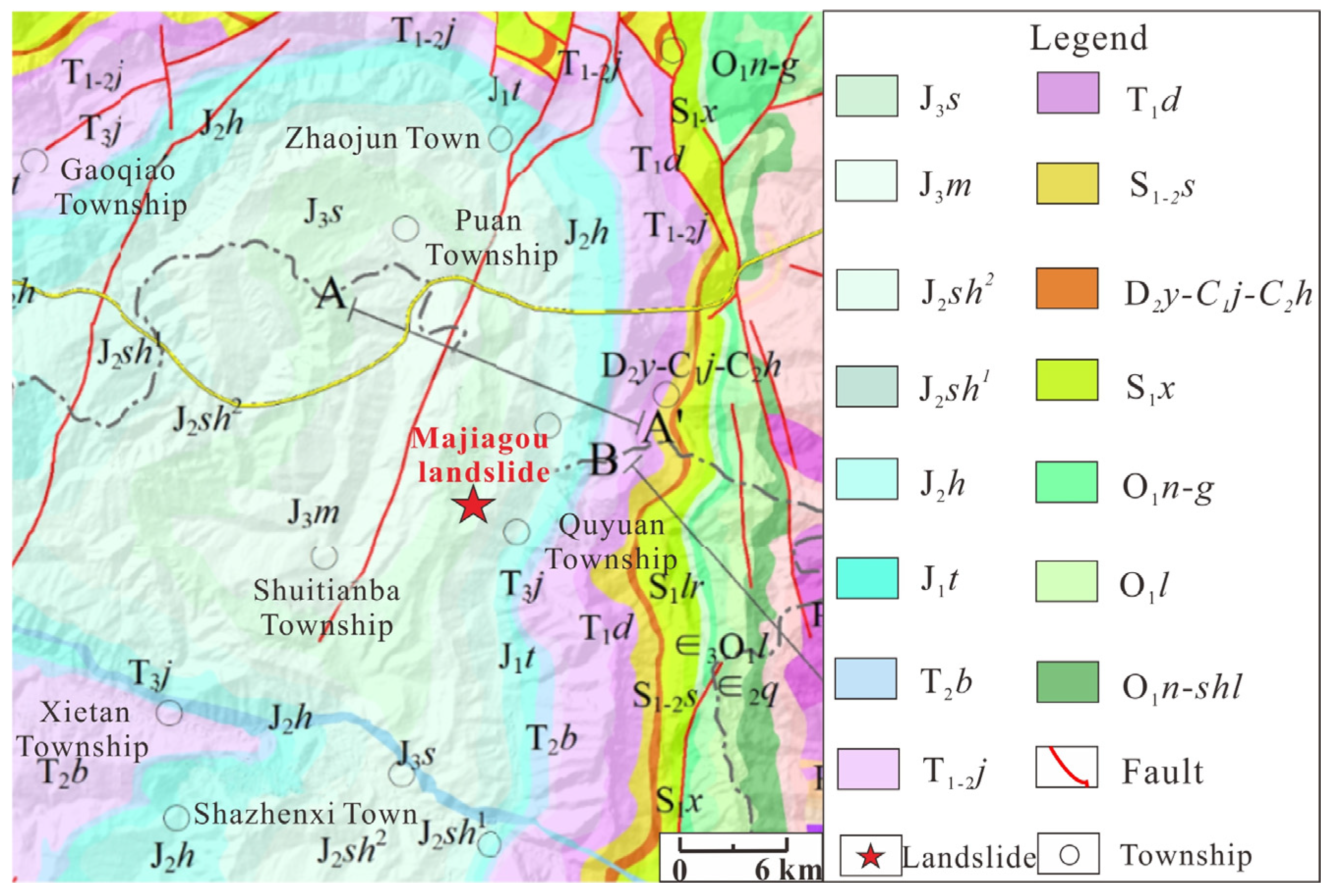
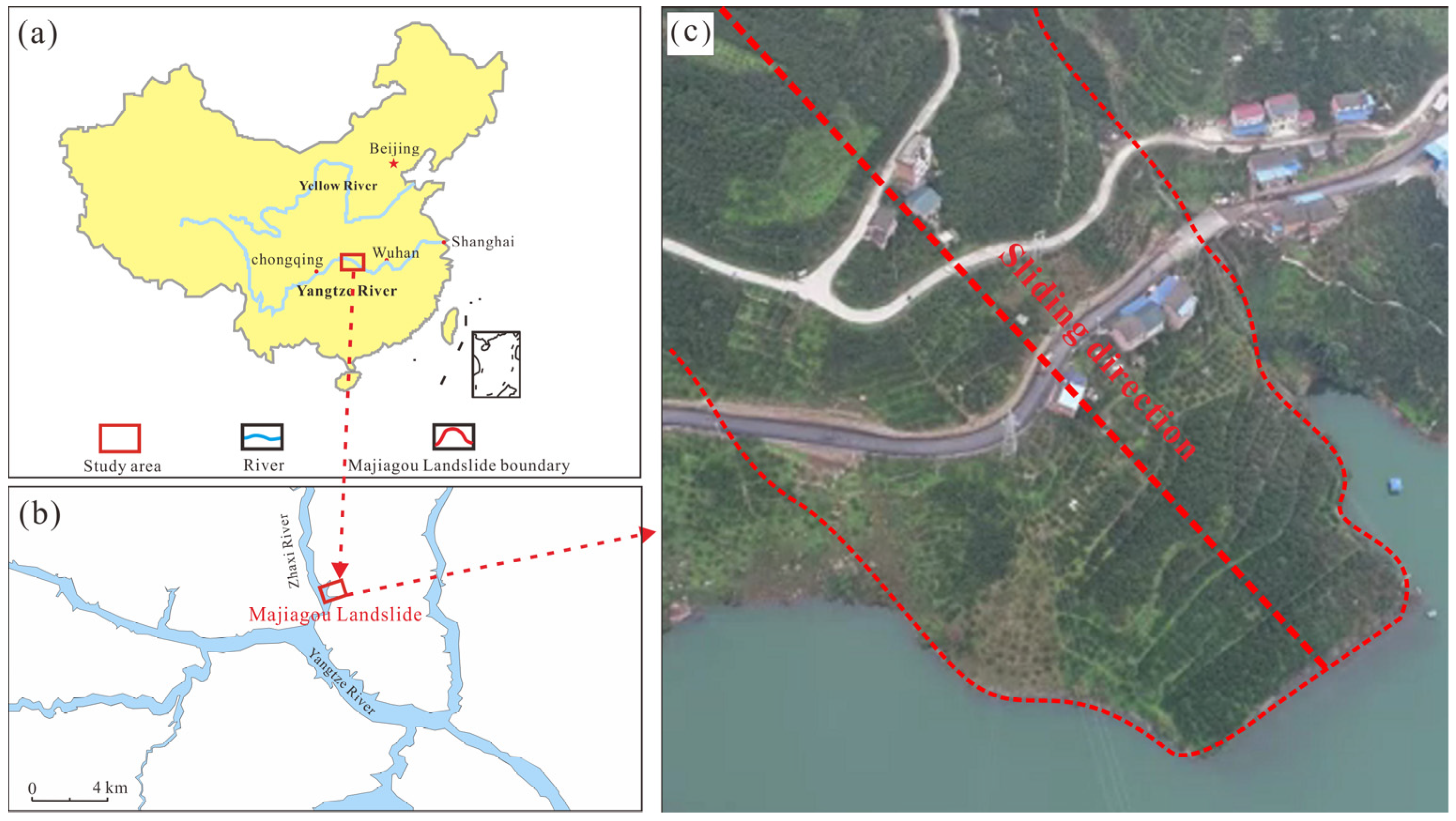
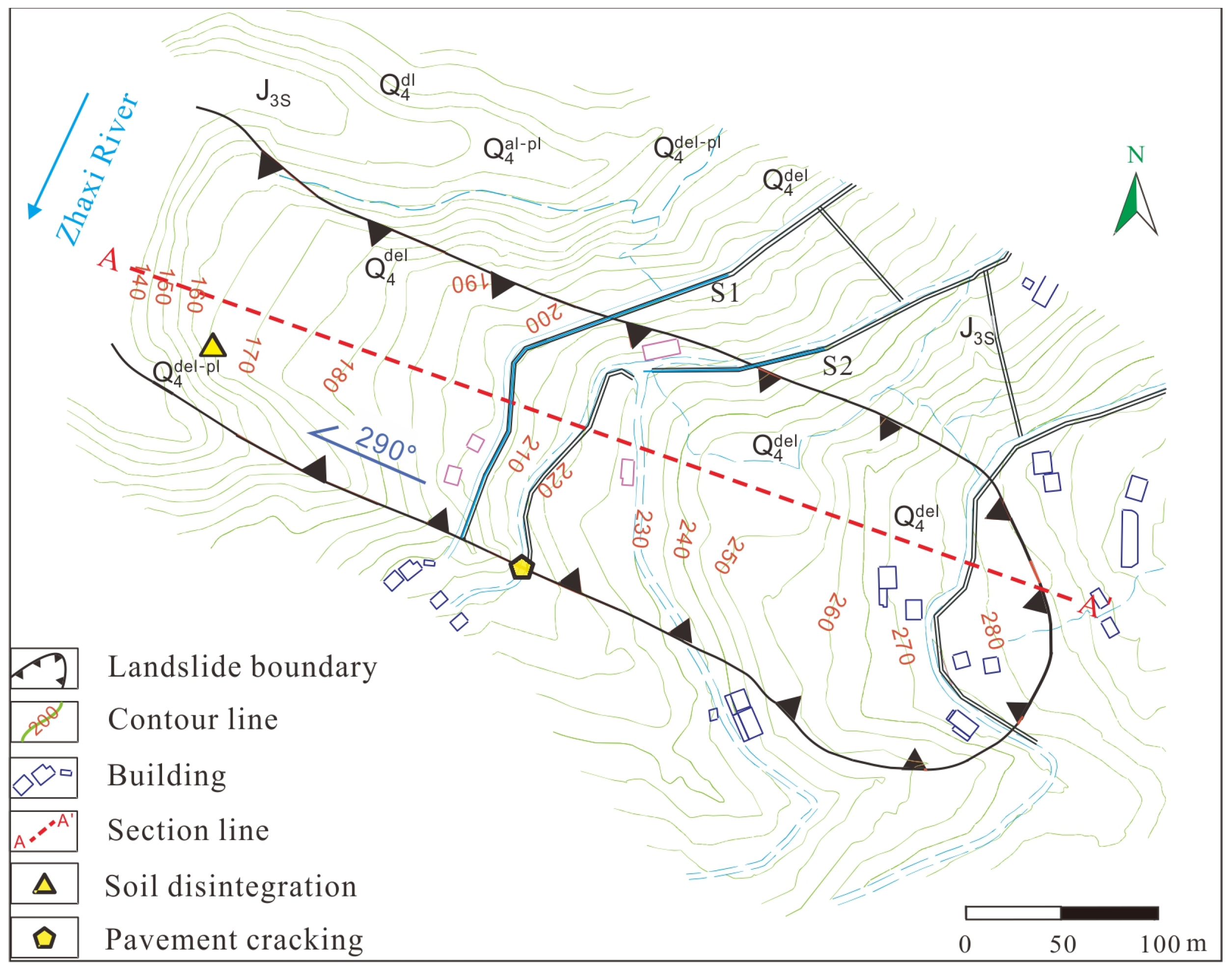
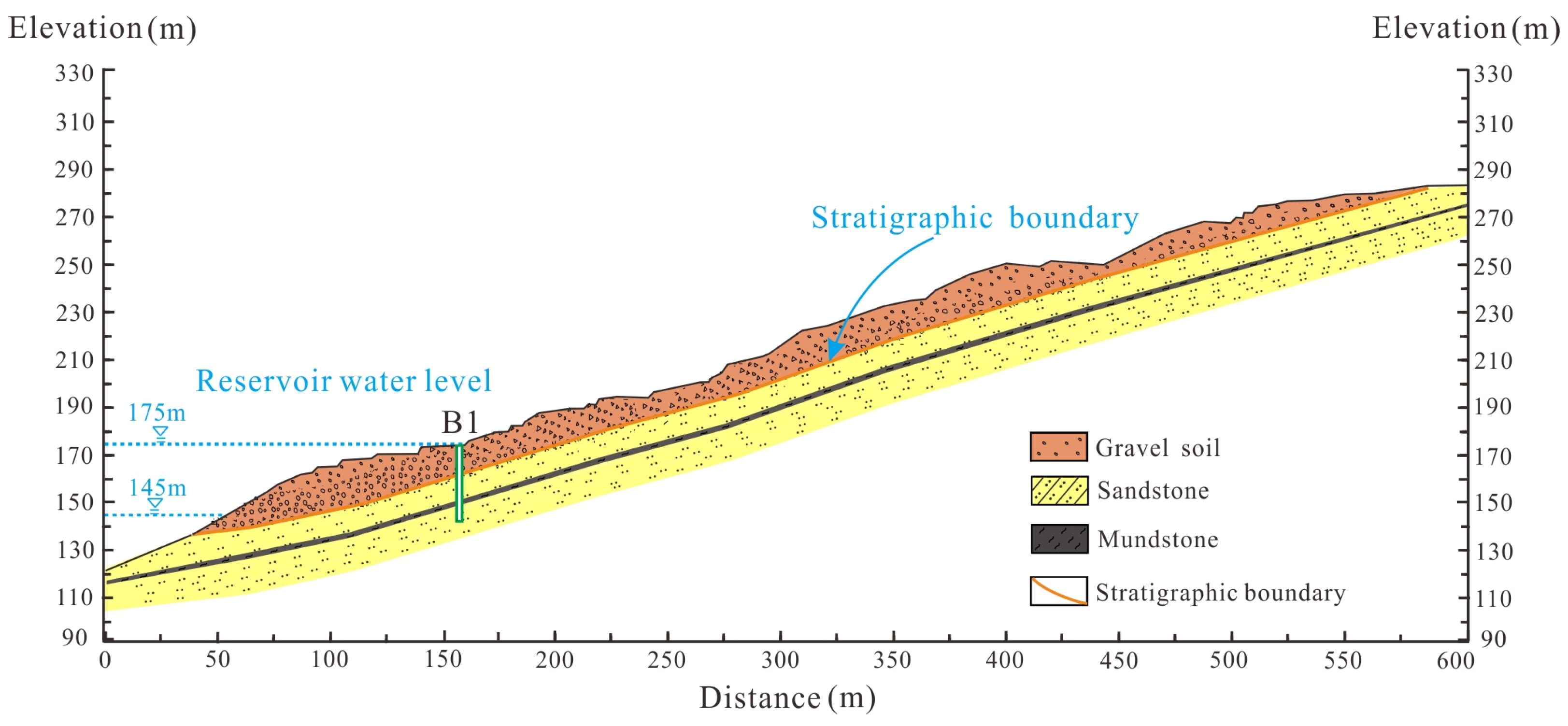
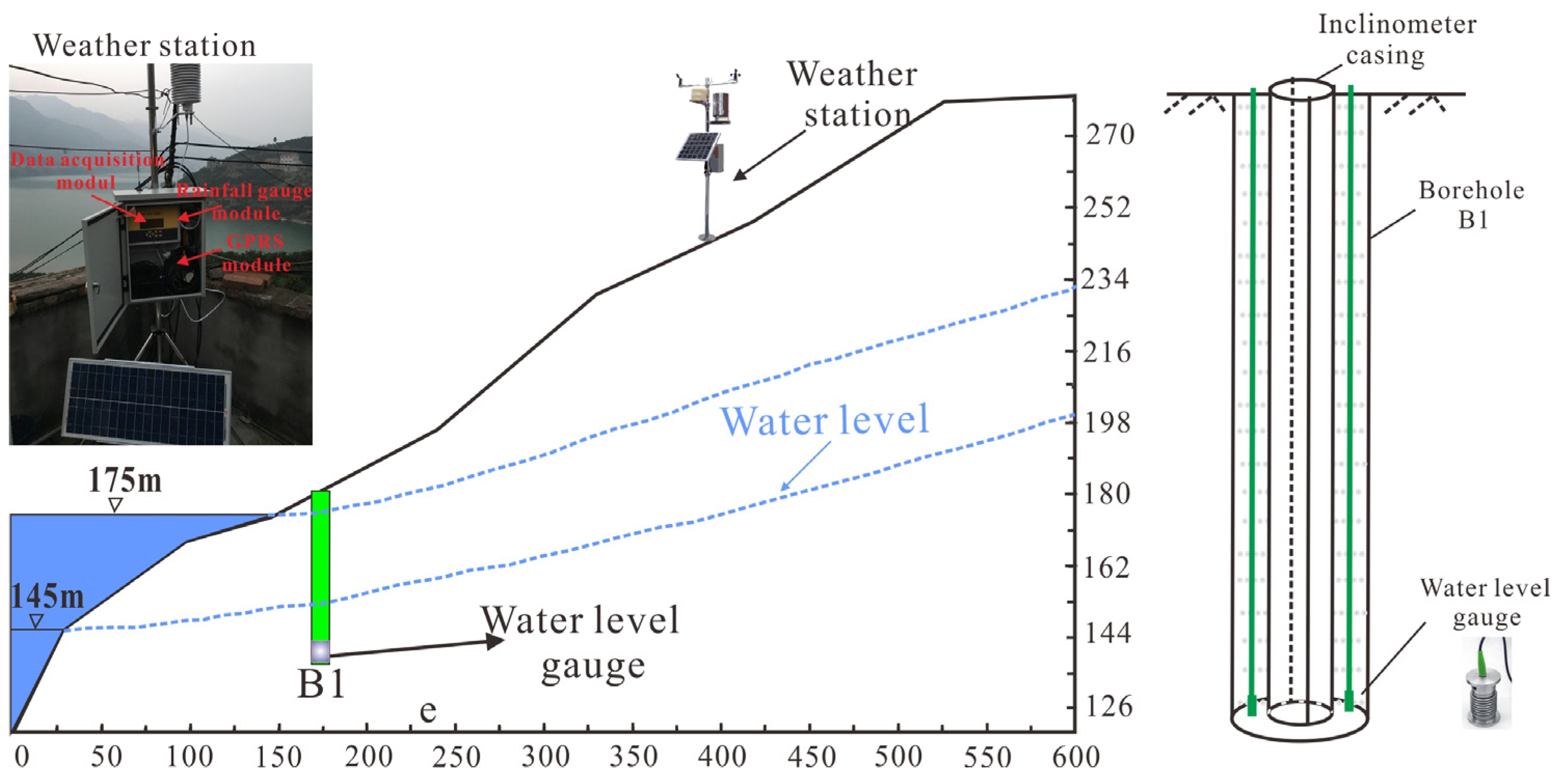
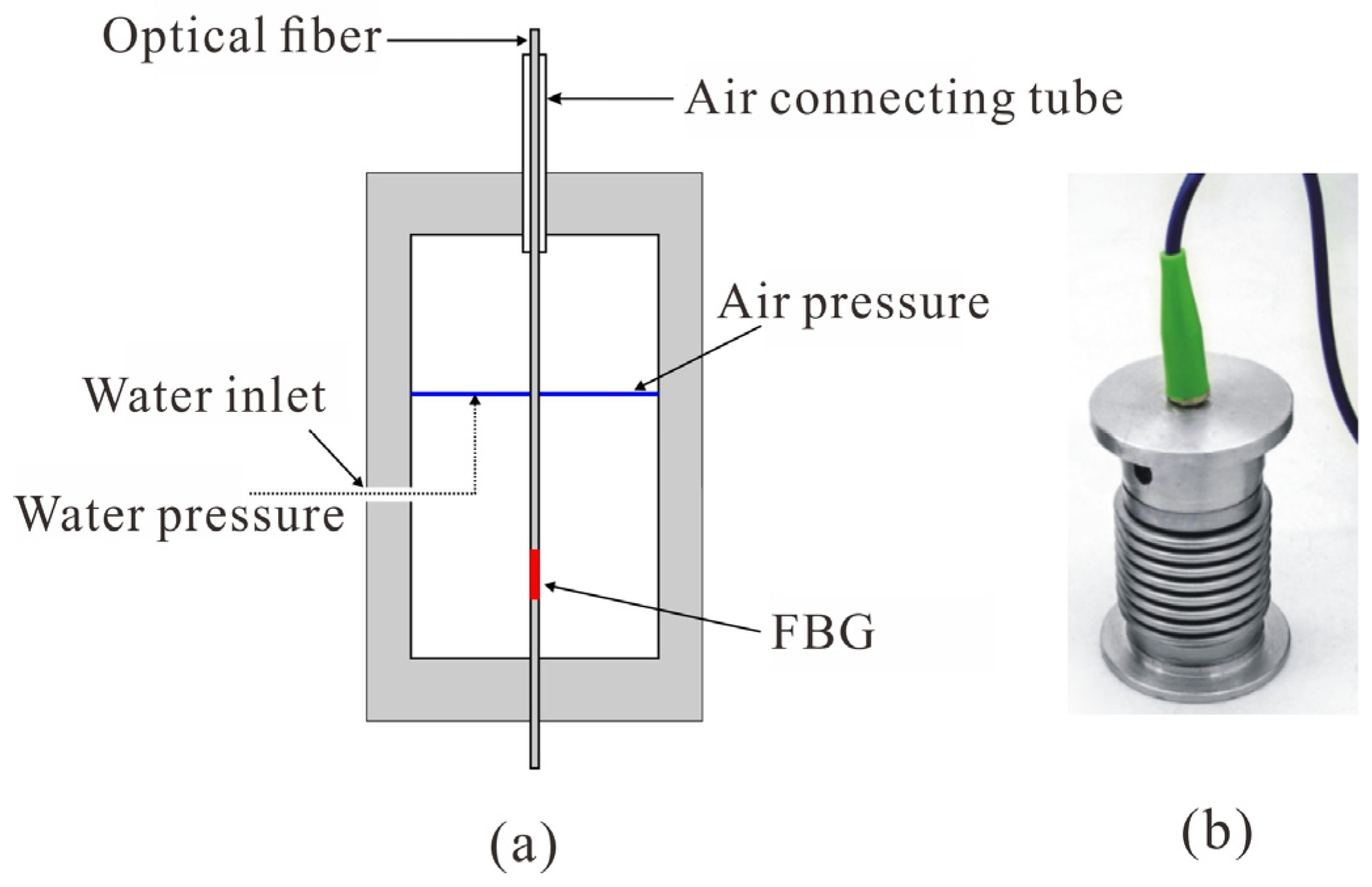
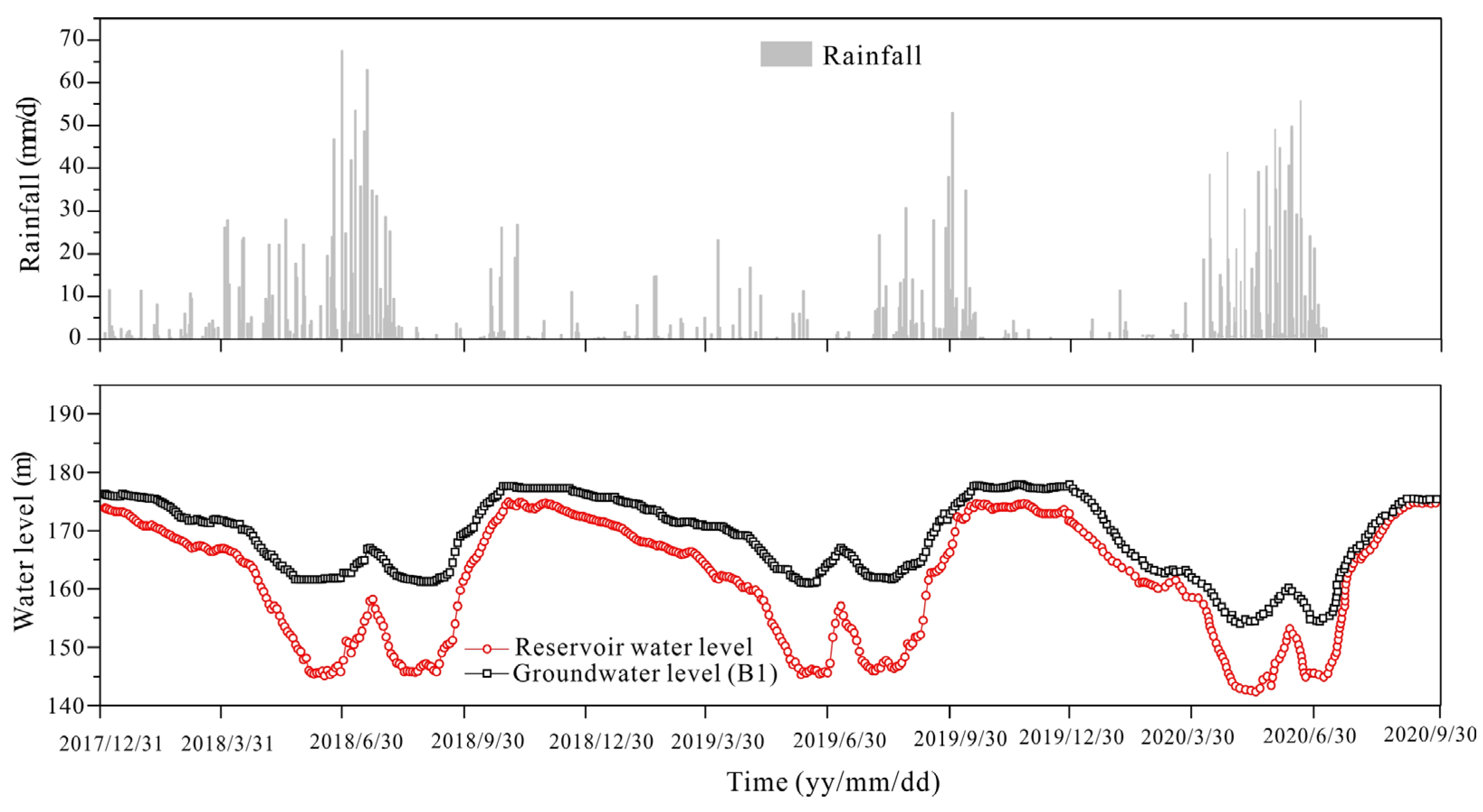

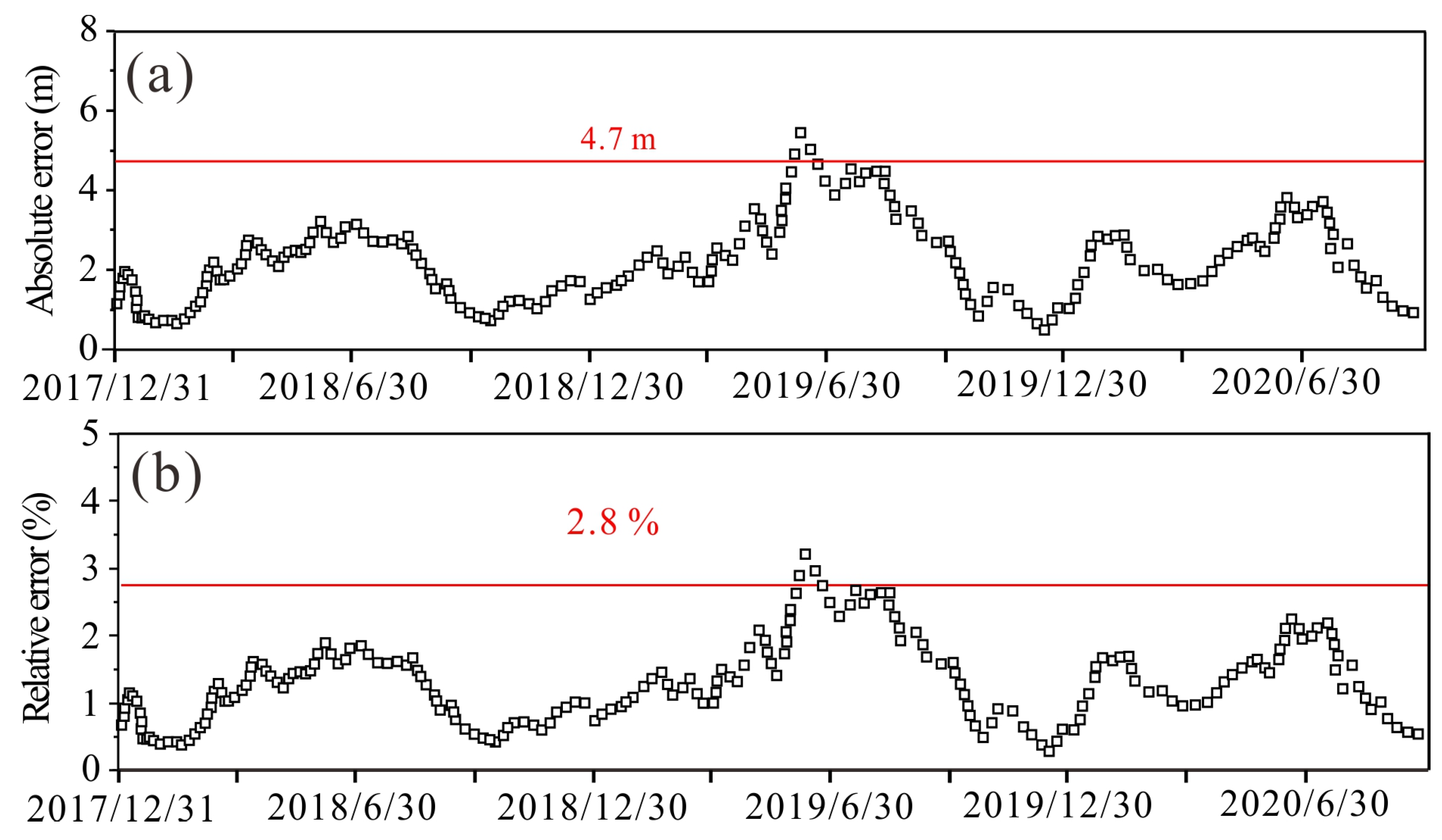
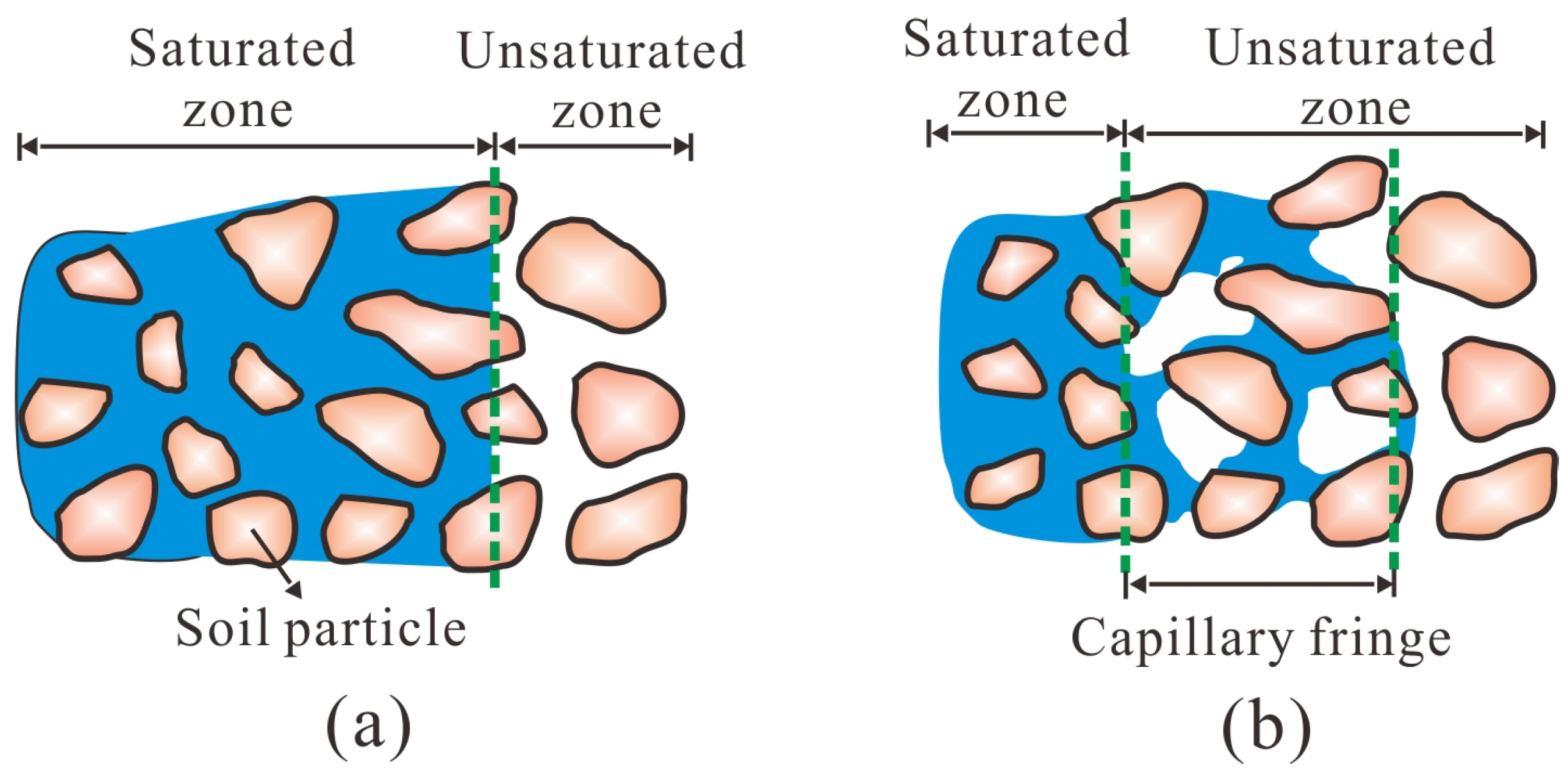
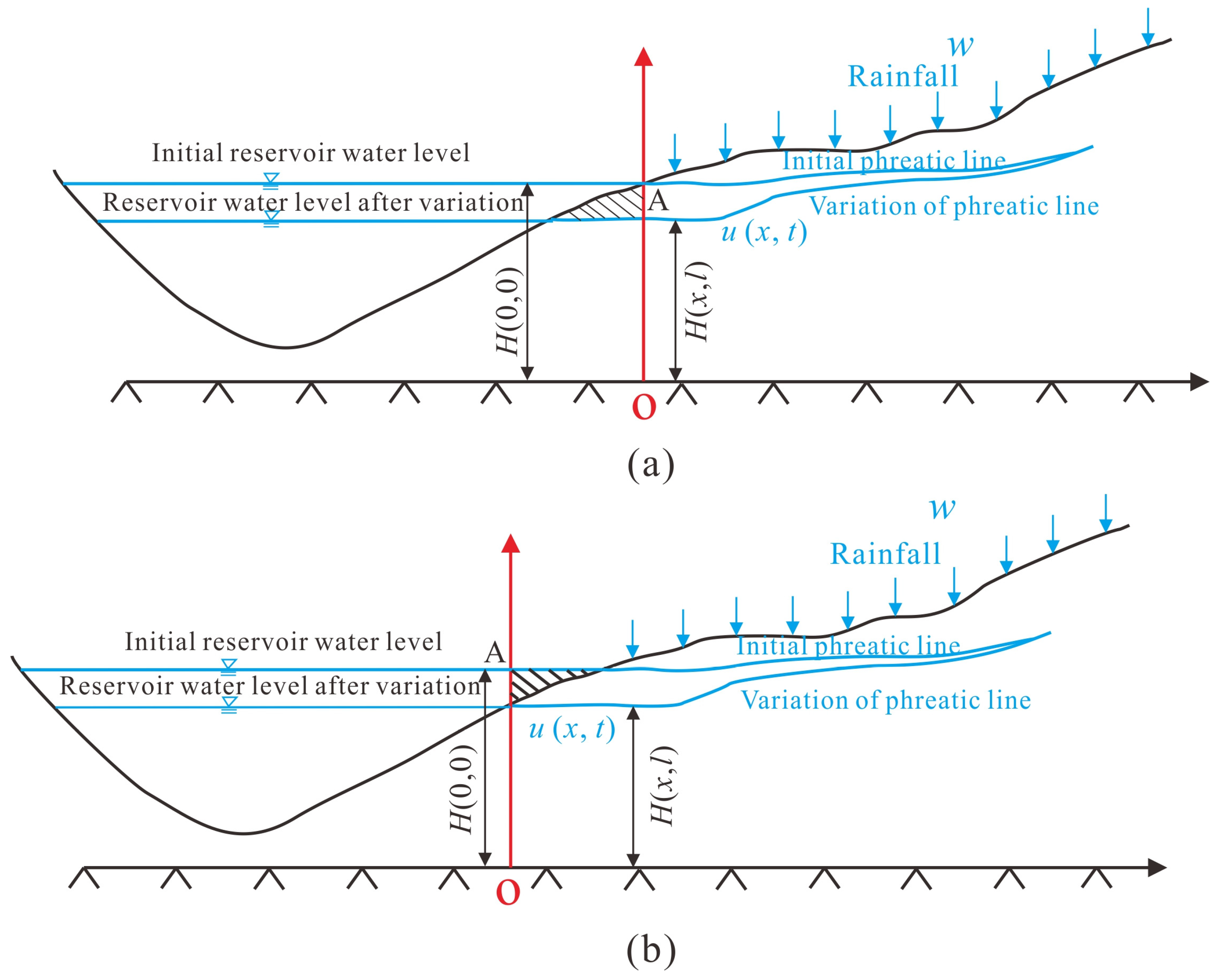
| Gravity Water Yield μ | Thickness of the Aquifer hm (m) | Permeability Coefficient K (cm/s) | The Distance x (m) | |
|---|---|---|---|---|
| Sliding body | 0.082 | 15 | 1.17 × 10−2 | 110 |
| Sliding bed | / | 6.43 × 10−4 |
Disclaimer/Publisher’s Note: The statements, opinions and data contained in all publications are solely those of the individual author(s) and contributor(s) and not of MDPI and/or the editor(s). MDPI and/or the editor(s) disclaim responsibility for any injury to people or property resulting from any ideas, methods, instructions or products referred to in the content. |
© 2024 by the authors. Licensee MDPI, Basel, Switzerland. This article is an open access article distributed under the terms and conditions of the Creative Commons Attribution (CC BY) license (https://creativecommons.org/licenses/by/4.0/).
Share and Cite
Zhang, L.; Ma, C.; Yuan, J.; Wu, J.; Han, H. Phreatic Line Calculation of Reservoir Landslide under Complex Hydraulic Conditions—A Case Study. Water 2024, 16, 375. https://doi.org/10.3390/w16030375
Zhang L, Ma C, Yuan J, Wu J, Han H. Phreatic Line Calculation of Reservoir Landslide under Complex Hydraulic Conditions—A Case Study. Water. 2024; 16(3):375. https://doi.org/10.3390/w16030375
Chicago/Turabian StyleZhang, Lei, Chengming Ma, Jiachen Yuan, Jinghong Wu, and Heming Han. 2024. "Phreatic Line Calculation of Reservoir Landslide under Complex Hydraulic Conditions—A Case Study" Water 16, no. 3: 375. https://doi.org/10.3390/w16030375
APA StyleZhang, L., Ma, C., Yuan, J., Wu, J., & Han, H. (2024). Phreatic Line Calculation of Reservoir Landslide under Complex Hydraulic Conditions—A Case Study. Water, 16(3), 375. https://doi.org/10.3390/w16030375







